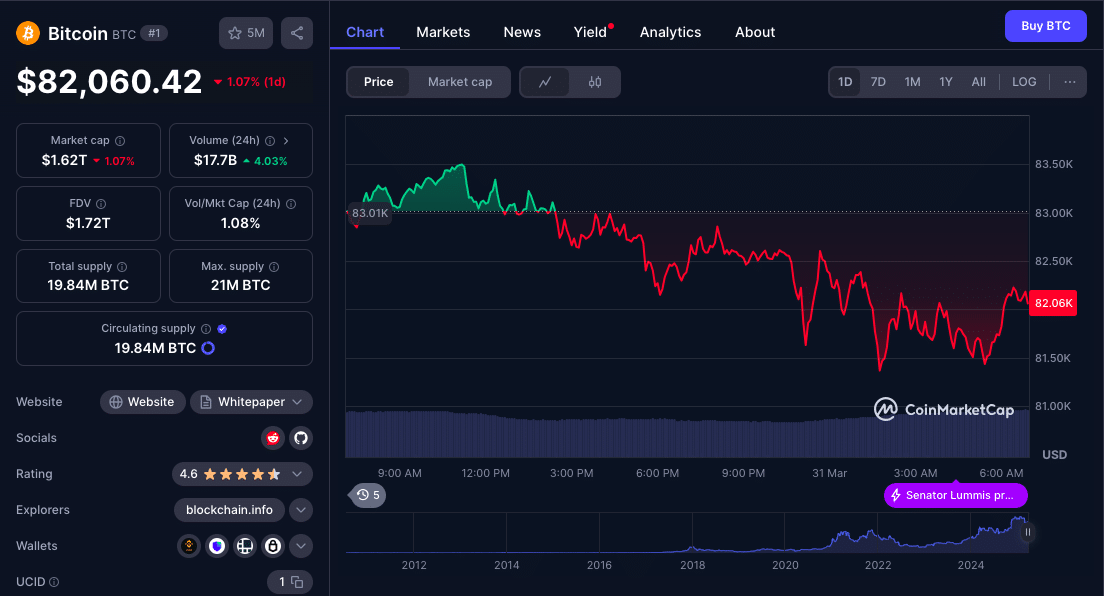 CaryptosHeadlines Media Has Launched Its Native Token CHT.
Airdrop Is Live For Everyone, Claim Instant 5000 CHT Tokens Worth Of $50 USDT.
Join the Airdrop at the official website,
CryptosHeadlinesToken.com
CaryptosHeadlines Media Has Launched Its Native Token CHT.
Airdrop Is Live For Everyone, Claim Instant 5000 CHT Tokens Worth Of $50 USDT.
Join the Airdrop at the official website,
CryptosHeadlinesToken.com
According to latest reports, Bitcoin ETFs have seen a big reversal, with a $93 million outflow on Friday, ending a 10-day accumulation streak that added $1.07 billion to the market. Despite that, Bitcoin’s price held up, bouncing back from a 10-day low of $82,000 to $84,000 over the weekend.
According to FairSide data, the outflows were all from Fidelity’s FBTC, while BlackRock’s iShares Bitcoin Trust (IBIT) and other U.S.-approved ETFs were neutral. This means there’s a potential divergence in institutional sentiment, with some investors taking profits and others holding.
With ETFs having played a big role in BTC’s recent price action, everyone’s watching to see if this is a temporary pause or a bigger shift.
Institutional Sentiment Remains Cautious as Regulators Get Busy
Bitcoin’s short dip below $82,000 coincided with more regulatory uncertainty in the U.S. Congress. Lawmakers are questioning Paul Atkins, a pro-crypto SEC chair nominee under Donald Trump, and speculation is growing about regulatory changes that could impact digital assets.
Despite the outflows, BlackRock and other big institutions are holding rather than selling, implying a long-term, calculated play on Bitcoin. Institutions are carefully watching macro risks, especially Trump’s trade policies and how they impact traditional markets and Bitcoin in their portfolios.


Bitcoin’s non-correlated status continues to attract capital, and it’s being seen as a hedge against economic instability. The outflows were concentrated in Fidelity’s FBTC, not all ETFs, so it was an isolated sell rather than a broad based one.
$82K Support Holds as ETFs Drive Market
Before the ETF sell-off, Bitcoin ETFs had added $1.07 billion in BTC over a 10-day period. That is a lot of supply being taken out of the market, which helped BTC hold above $82,000. Also, many ‘institutions entered the market when Bitcoin was below $77,000 implying that they are currently in profit and don’t have to sell in a hurry. As a result, Bitcoin’s price has held up while Ethereum (ETH), Solana (SOL), and Ripple (XRP) are ‘struggling.
Institutional Activity: Fidelity vs. BlackRock
| ETF Provider | Latest Net Flow | Total Holdings | Price Impact |
|---|---|---|---|
| Fidelity (FBTC) | -$93M | 140K BTC | Profit-taking led to dip |
| BlackRock (IBIT) | Neutral | 280K BTC | No change in holdings |
| Grayscale (GBTC) | Neutral | 300K BTC | Gradual outflows continue |
Fidelity’s move means some institutions are taking profits, but BlackRock and Grayscale not selling means they are more confident in the long-term.
Bitcoin Price Outlook: Will BTC hold above $82K or break lower?
Bitcoin’s short-term price outlook is uncertain as it’s at $82,060, right above support. Technical indicators are flashing a warning sign: Bollinger Bands are tightening. This usually means a breakout-or-breakdown situation could be brewing. Resistance is at $84,412, with major upside targets stretching to $88,215.


Key Technical Levels to Watch
| Indicator | Current Reading | Implication |
|---|---|---|
| Bollinger Bands | Tightening volatility | Breakout imminent |
| Resistance Levels | $84,400 / $88,200 | Potential breakout triggers |
| Support Levels | $82,000 / $80,237 | Possible downside targets |
| Bearish Pennant Formation | Forming | Could indicate further downside |
If Bitcoin can’t break past $84,400, a bearish scenario could unfold. That could send BTC plummeting to $80,600 or even test the lower Bollinger Band at $80,237.
But if Bitcoin holds above $82,000 and volume really picks up, it could invalidate that bearish pennant pattern and set the stage for another rally toward $88,215.
Bitcoin ETF Demand: What’s Next?
The next few weeks will be noteworthy in determining whether Bitcoin ETFs resume their accumulation trend-or if further outflows signal a shift in institutional ‘sentiment. Investors are watching three key areas: Regulatory developments in the U.S., Macroeconomic trends that affect risk assets, Federal Reserve interest rate policies.
If macroeconomic conditions favor Bitcoin’s role as a hedge against inflation, we could see ETF inflows return-and push BTC toward new all-time highs. Uncertainty or unfavorable policies from ‘regulators could, however, send Bitcoin into deeper corrections.
BlackRock’s decision to hold onto BTC signals long-term confidence. Fidelity’s outflows, on the other hand, suggest short-term caution.
FAQs
Why did Bitcoin ETFs see outflows after a 10-day accumulation streak?
Bitcoin ETFs saw $93 million in outflows, mainly from ‘Fidelity’s FBTC. Some institutional investors took profits after the strong accumulation phase.
Does this ETF outflow indicate a bearish trend for Bitcoin?
Not necessarily. While Fidelity’s ETF offloaded BTC, BlackRock and other major ETFs’ maintained their holdings. That suggests a mixed sentiment rather than an outright bearish shift.
What are the key resistance and support levels for Bitcoin?
Bitcoin faces resistance at $84,400 and $88,215. If it fails to’ break past $84,400, support levels at $82,000 and $80,237 become critical.
How does Bitcoin’s price correlate with ETF flows?
ETF inflows reduce market ‘supply, pushing prices higher. Outflows can increase selling pressure, leading to potential price declines.
What factors could influence Bitcoin ETF inflows in the coming weeks?
Regulatory developments, macroeconomic ‘conditions and investor sentiment will be the key drivers of future Bitcoin ETF demand.
Glossary
Bitcoin ETF: A financial product that lets investors gain exposure to ‘Bitcoin without directly holding the asset.
Spot ETF: An ETF backed by actual Bitcoin holdings rather than futures contracts.
Bollinger Bands: A volatility indicator used to ”assess potential breakout points in price charts.
Bearish Pennant Formation: A technical pattern that suggests potential downside if price fails to ‘break above key resistance.
Macroeconomic Risks: Economic factors like ‘inflation, interest rates and geopolitical events that impact financial markets.
References
Disclaimer
This article is meant to inform, not advise. Cryptocurrency ‘investments are subject to market risk—and past performance is never a guarantee of future success. That means you should do your own research and talk to a financial professional before making any investment decisions.












